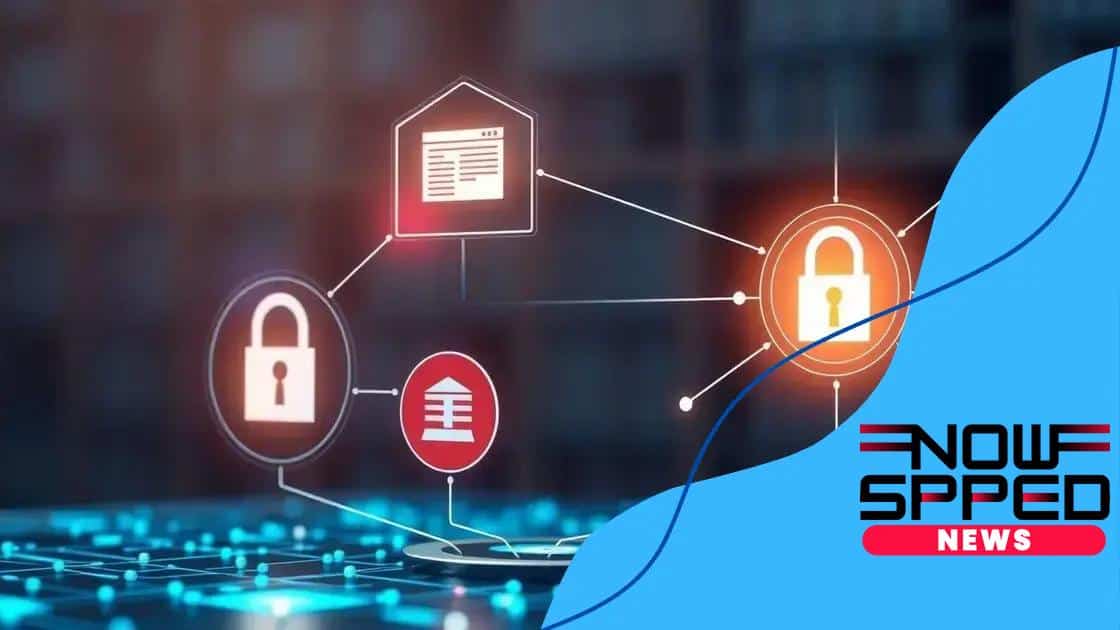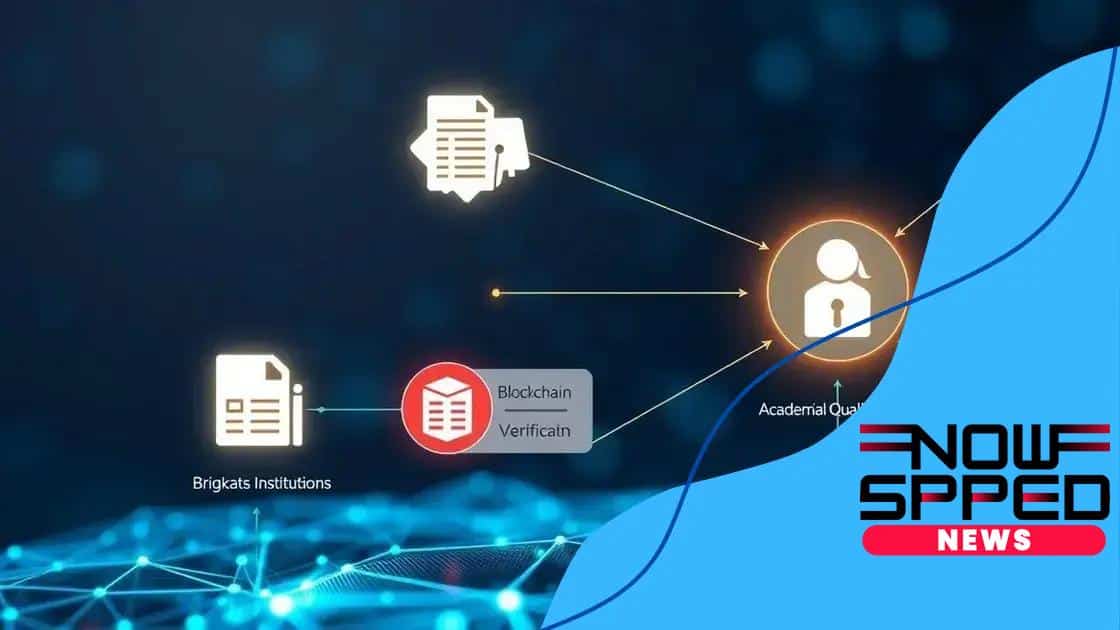Blockchain in academic credential authentication: A game changer

Blockchain in academic credential authentication enhances security, efficiency, and accessibility by providing a decentralized and verifiable system for managing and validating educational achievements.
Blockchain in academic credential authentication is reshaping how we verify educational achievements. Have you ever wondered how a secure digital record could change hiring processes? Let’s explore this intriguing topic.
Understanding blockchain technology
Understanding blockchain technology is essential for grasping its impact on various sectors, especially education. At its core, blockchain is a decentralized and secure digital ledger that records transactions across many computers. This technology ensures that records are immutable, meaning once data is entered, it cannot be altered or deleted.
The key features of blockchain include transparency, security, and efficiency. Every participant in the network has access to the same information, promoting trust and reducing the likelihood of fraud.
Key Components of Blockchain
To better understand how blockchain works, it’s important to recognize its main components:
- Blocks: These are units that store data.
- Chain: This is the sequence of blocks, linked together in chronological order.
- Nodes: These are the computers that maintain and validate the blockchain.
- Consensus Mechanisms: These are protocols that determine how transactions are verified and added to the blockchain.
These components work together to ensure the integrity and efficiency of the data recorded. For instance, when a new academic credential is issued, it gets added as a block. Through the consensus mechanism, all nodes in the network verify this addition, maintaining trust in the process.
Moreover, blockchain technology offers several advantages that make it particularly appealing for academic credential authentication. It eliminates the risk of lost or fake credentials and simplifies the verification process for employers and institutions alike. By using a digital record system, educational institutions can quickly and accurately verify a candidate’s qualifications.
Overall, understanding blockchain technology helps to appreciate its transformative potential in managing academic credentials. As more institutions adopt this technology, it becomes increasingly clear how blockchain can efficiently address long-standing challenges in verifying educational qualifications.
The role of blockchain in education
The role of blockchain in education is becoming increasingly significant as institutions seek more secure and efficient ways to manage academic records. This technology can fundamentally change how credentials are granted, verified, and shared. With blockchain, students can have permanent, secure records of their achievements at their fingertips.
For educational institutions, blockchain offers a way to enhance the integrity of their records. By using this technology, schools can defend against fraud and ensure that only verified diplomas and transcripts are issued. This can be a game changer in today’s world, where fake credentials can hinder recruitment processes.
Benefits of Blockchain in Education
The implementation of blockchain technology in education provides several benefits:
- Security: Blockchain ensures that data cannot be tampered with or altered, preserving the authenticity of academic records.
- Transparency: All transactions can be viewed by authorized parties, fostering trust amongst institutions and employers.
- Accessibility: Students can access their credentials anytime, making it easier to share with potential employers.
- Efficiency: The verification process can be shortened significantly, saving time for both candidates and recruiters.
Moreover, educational institutions can leverage blockchain to establish clear ownership of credentials. This ownership is essential, as it allows students to hold their own records instead of relying solely on issuing institutions. With a decentralized system, students have more control over their own academic histories.
The role of blockchain in education is not just about storing data; it also involves creating collaborative environments between institutions. For instance, multiple universities can share data on student achievements seamlessly. This collaboration could result in more comprehensive educational records that include not just grades but also skills and competencies.
As educational institutions begin to adopt blockchain, the potential for revolutionizing how we think about education continues to grow. Increased efficiency and security promise a better experience for students, schools, and employers alike.
How blockchain enhances credential verification

How blockchain enhances credential verification is a pivotal topic in today’s digital education landscape. Blockchain technology offers a robust framework to verify academic credentials efficiently and securely. With traditional systems, verifying a diploma can take days or even weeks, whereas blockchain can expedite this process significantly.
The primary advantage of using blockchain for credential verification lies in its decentralized structure. This means that no single entity controls the data, creating a more trustworthy environment where records can be independently validated. Institutions can easily check the authenticity of credentials against the blockchain, eliminating the hassle of contacting previous schools.
Key Features of Blockchain in Verification
There are several key features of blockchain that enhance the verification process:
- Immutability: Once a record is added to the blockchain, it cannot be altered, ensuring that the information remains accurate.
- Speed: The time it takes to verify credentials is reduced to minutes rather than days.
- Accessibility: Authorized parties can access records anywhere in the world, making verification easy and efficient.
- Cost-Effectiveness: Reduces the administrative costs associated with verifying credentials due to streamlined processes.
Educators can issue digital diplomas directly onto the blockchain, which students can then share with potential employers. This not only speeds up the hiring process but also boosts confidence in the quality of education received. By having a secure, verifiable record, graduates can stand out in a competitive job market.
Moreover, employers can save time and resources by relying on automatic verification. No longer do they need to sift through piles of applications to check for authenticity. Instead, they can focus on finding the best candidates based on their true qualifications. Through blockchain technology, the link between education providers and employers becomes clearer.
Overall, blockchain not only enhances credential verification but also transforms how we perceive the value of academic achievements. As this technology continues to evolve, its influence on education and employment will likely expand, leading to a more reliable and efficient system for everyone involved.
Challenges in implementing blockchain solutions
Challenges in implementing blockchain solutions are crucial to understanding its potential within academic credentialing. While blockchain offers numerous benefits, several obstacles can hinder its widespread adoption. For instance, technical complexity can pose significant challenges for institutions looking to integrate this technology into existing systems.
Many educational institutions may lack the necessary expertise or resources to implement blockchain effectively. This knowledge gap can slow down progress and lead to misunderstandings about the technology’s capabilities. Many are still unsure of how to balance traditional methods with new blockchain systems.
Common Obstacles to Adoption
Several challenges often arise when educational institutions consider adopting blockchain technology:
- Regulatory Concerns: Institutions must navigate a maze of regulations regarding data privacy and security, which can complicate implementation.
- Interoperability: Integrating blockchain with existing systems can be difficult, as different platforms may not communicate effectively with each other.
- Cost of Implementation: The initial investment necessary for blockchain technology might deter schools, particularly those with limited budgets.
- Lack of Awareness: Many educators and administrators may not fully understand blockchain technology, causing hesitation in making changes.
Moreover, fostering collaboration among multiple stakeholders—such as universities, employers, and technology providers—can be challenging. Each party may have different goals and priorities, making it vital to establish a clear framework for cooperation.
In addition to these technical and organizational challenges, there is the need for cultural change within institutions. Educators and administrators are often set in their ways, making it difficult to embrace new technologies. Overcoming this resistance requires thorough training and awareness programs to highlight the advantages of blockchain.
Ultimately, while the challenges to implementing blockchain solutions are significant, they must be addressed head-on to unlock its full potential in credential verification and beyond.
Future trends in academic credentials
Future trends in academic credentials highlight the growing impact of technology on education and the need for more secure and verified systems. As we move forward, the integration of blockchain technology is expected to play a pivotal role in shaping how credentials will be managed and recognized.
One major trend is the shift towards digital credentials. Traditional paper diplomas are giving way to digital badges and certificates stored on the blockchain. This transition allows for easier sharing and verification of achievements. Employers can quickly verify qualifications, enhancing the hiring process.
Key Trends to Watch
The following trends will likely shape the future of academic credentials:
- Increase in Competency-Based Education: Learners will be assessed based on skills and competencies rather than just formal degrees.
- Micro-Credentials: Short, targeted courses will gain popularity, allowing individuals to earn credentials in specific areas without committing to a full degree.
- Employer-Requested Credentials: Organizations may require specific digital badges as proof of skills when hiring, leading to a more tailored educational path.
- Unified Credential Frameworks: Collaborations among educational institutions will develop standardized methods for issuing and verifying academic credentials.
Moreover, as blockchain becomes more widely adopted, interoperability between different platforms will improve. This means students can carry their credentials across borders seamlessly, enhancing global mobility. An individual’s verified academic record will be accessible regardless of where they are in the world.
There’s also a growing focus on data privacy and security. Educational institutions will need to ensure that student data is protected while still being verifiable. This balance is critical in building trust with learners and employers alike.
As we look to the future, the continued evolution of academic credentials will likely lead to a more inclusive and accessible education system, where learning is recognized in various forms and students can showcase their unique skills.
FAQ – Frequently Asked Questions about Blockchain in Academic Credentialing
How does blockchain enhance the verification of academic credentials?
Blockchain enhances verification by providing a secure, decentralized system that allows for rapid validation of credentials without the risk of fraud.
What are digital credentials, and why are they important?
Digital credentials are electronic representations of qualifications, making it easier to share and verify achievements in a fast and efficient manner.
What challenges do institutions face when implementing blockchain technology?
Institutions may struggle with technical complexity, regulatory concerns, and the need for staff training to adapt to new systems.
What future trends are expected in academic credentialing?
Future trends include the rise of micro-credentials, competency-based education, and improved global mobility for students as they share their verified qualifications.





